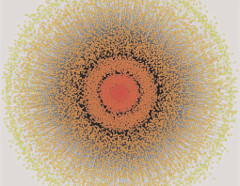Nov. 18, 2015
K computer takes first place again in Graph 500 supercomputer ranking
 The illustration shows a graph with 16,000 edges. The task for GRAPH 500 was to solve a search of an extremely large graph with 16 trillion edges. The team performed this feat in 0.45 seconds on the K computer!
The illustration shows a graph with 16,000 edges. The task for GRAPH 500 was to solve a search of an extremely large graph with 16 trillion edges. The team performed this feat in 0.45 seconds on the K computer!
A collaboration between RIKEN, Tokyo Institute of Technology, University College Dublin, Kyushu University, and Fujitsu Limited has, for the second consecutive time, won top place for the K computer in the November 2015 Graph 500 supercomputer ranking, demonstrating the Japanese supercomputer’s prowess in the area of data-intensive processing. The results were announced on November 17 at the international conference for high-performance computing, networking, storage and analysis (SC15) in Austin, Texas.
The Graph 500 ranking is a relatively new benchmark, first issued in 2010, which seeks to gauge the ability of supercomputers on data-intensive loads rather than simple speed, with the goal of improving computing involving complex data problems in areas such as cybersecurity, medical informatics, data enrichment, social networks, symbolic networks, and modeling neuronal circuits in the brain.
To conduct the benchmark measurement, Koji Ueno of Tokyo Institute of Technology and RIKEN, along with colleagues, used 82,944 of the K computer’s 88,128 compute nodes to solve a breadth-first search of an extremely large graph of 1 trillion nodes and 16 trillion edges in 0.45 of a second. With this achievement it gained the top place again with a score of 38,621 gigaTEPS.
According to Ueno, who led the team, “I am delighted that we have been able to take the top spot again, after winning it in July. The fact that we could take top place twice in a row on the highly competitive Graph 500 benchmark demonstrates the outstanding performance of the K computer’s hardware and the method we developed to take maximum advantage of it. We will continue our efforts to see how far we can develop the K computer’s potential." The K computer’s triumph under the new ranking shows that it excels not only at regular parallel computing but also at graph analysis, which relies heavily on irregular computations, and demonstrates the flexibility of the K computer in application to a wide range of applications.
Two research projects funded by Japan Science and Technology Agency (JST) CREST programs contributed to this achievement: “Advanced Computing and Optimization Infrastructure for Extremely Large-Scale Graphs on Post Peta-Scale Supercomputers” (PI: Prof. Katsuki Fujisawa of Kyushu University and Co-PI: Prof. Toyotaro Suzumura of University College Dublin), which is a project in the research area of Development of System Software Technologies for Post-Peta Scale High Performance Computing (Research Supervisor: Prof. Mitsuhisa Sato of RIKEN), and “EBD: Extreme Big Data - Convergence of Big Data and HPC for Yottabyte Processing” (PI: Prof. Satoshi Matsuoka of Tokyo Institute of Technology), which is a project in the Advanced Core Technologies for Big Data Integration area (Research Supervisor: Prof. Masaru Kitsuregawa of the National Institute of Informatics).
